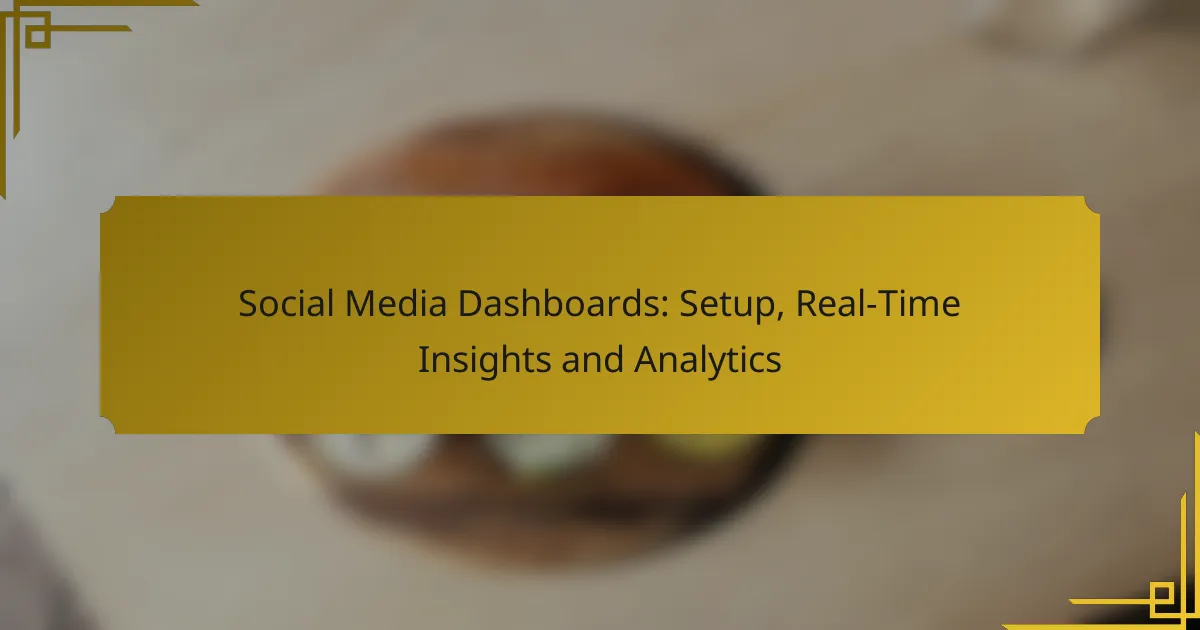Social media dashboards are essential tools for businesses looking to monitor and analyze their online presence effectively. By setting up a dashboard, you can integrate your social media accounts and customize the layout to focus on key performance metrics, providing real-time insights that drive informed decision-making. These platforms enhance visibility into engagement and audience behavior, streamlining workflows and fostering collaboration among teams.

How to set up a social media dashboard?
Setting up a social media dashboard involves selecting a platform, integrating your accounts, and customizing the layout to monitor key metrics effectively. This process enables you to gain real-time insights and track performance across various social media channels.
Choose a platform like Hootsuite
Selecting a robust platform is crucial for effective social media management. Hootsuite is a popular choice, offering comprehensive tools for scheduling posts, tracking engagement, and analyzing performance. Other alternatives include Buffer and Sprout Social, each with unique features that may suit different needs.
Consider factors such as user interface, pricing, and the specific social networks you want to manage when choosing a platform. Most platforms offer free trials, allowing you to explore their functionalities before committing.
Integrate social media accounts
Once you have chosen a platform, the next step is to integrate your social media accounts. This typically involves logging into each account through the dashboard and granting necessary permissions for data access. Most platforms support major networks like Facebook, Twitter, Instagram, and LinkedIn.
Ensure that you connect all relevant accounts to get a comprehensive view of your social media presence. This integration allows for seamless data collection and reporting, making it easier to analyze performance across platforms.
Select key performance indicators
Identifying key performance indicators (KPIs) is essential for measuring the success of your social media efforts. Common KPIs include engagement rates, follower growth, click-through rates, and conversion metrics. Choose indicators that align with your business goals.
Consider using a mix of quantitative and qualitative metrics to get a well-rounded view of your performance. Regularly review and adjust your KPIs as your social media strategy evolves to ensure they remain relevant.
Customize dashboard layout
Customizing your dashboard layout helps you prioritize the information that matters most. Most platforms allow you to drag and drop widgets or modules to create a personalized view. Focus on displaying your selected KPIs prominently for quick access.
Consider grouping similar metrics together, such as engagement statistics or audience demographics, to streamline your analysis process. A well-organized dashboard can significantly enhance your ability to make data-driven decisions.
Set up real-time data feeds
Setting up real-time data feeds is vital for staying updated on your social media performance. Most platforms offer options to refresh data automatically, providing you with the latest insights without manual intervention. This feature is especially useful for monitoring live campaigns or events.
Ensure that your dashboard is configured to alert you to significant changes in performance metrics, such as spikes in engagement or drops in follower counts. These alerts can help you respond quickly to emerging trends or issues.
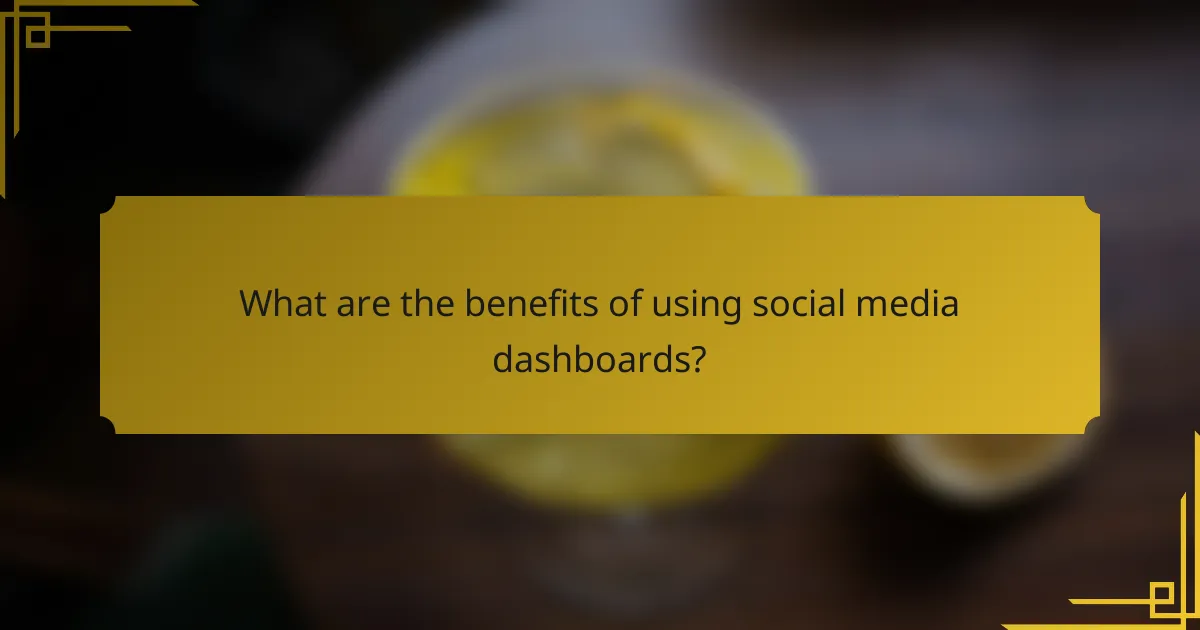
What are the benefits of using social media dashboards?
Social media dashboards provide a centralized platform for monitoring and analyzing social media performance, offering real-time insights that help businesses make informed decisions. They enhance visibility into key metrics, streamline workflows, and foster collaboration among teams.
Enhanced data visualization
Social media dashboards improve data visualization by presenting complex metrics in an easily digestible format. Charts, graphs, and heat maps allow users to quickly identify trends and patterns in engagement, reach, and conversions.
For example, a dashboard might display follower growth over time, engagement rates by post type, or audience demographics. This visual representation helps teams to quickly assess performance and adjust strategies accordingly.
Improved team collaboration
Using social media dashboards facilitates improved team collaboration by providing a shared view of performance metrics and campaign results. Team members can access the same data and insights, which promotes alignment on goals and strategies.
Additionally, many dashboards offer features like comment sections or task assignments, enabling teams to discuss insights and coordinate responses in real time. This reduces miscommunication and enhances the overall efficiency of social media efforts.
Streamlined reporting processes
Social media dashboards streamline reporting processes by automating data collection and report generation. Instead of manually compiling data from various platforms, dashboards aggregate information into comprehensive reports that can be generated on a regular basis.
For instance, a dashboard can automatically create weekly or monthly reports that summarize key performance indicators (KPIs) like engagement rates, audience growth, and campaign effectiveness. This saves time and ensures that reports are consistent and accurate.
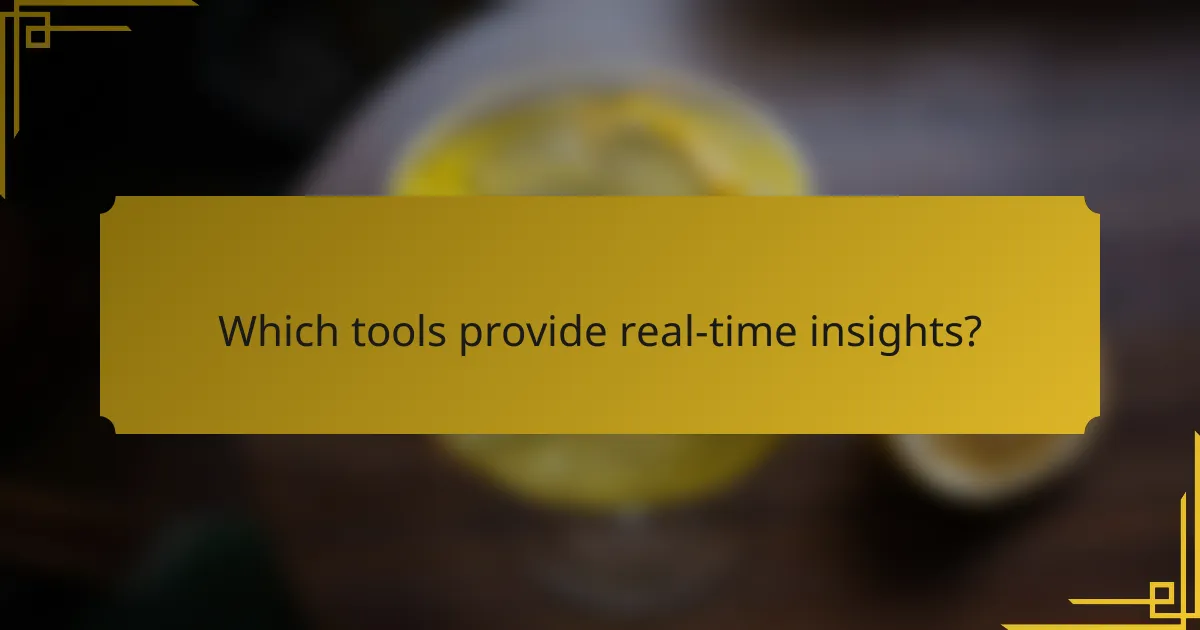
Which tools provide real-time insights?
Several tools offer real-time insights into social media performance, enabling businesses to make informed decisions quickly. These platforms help track engagement, audience behavior, and overall effectiveness of social media strategies.
Sprout Social for analytics
Sprout Social is a comprehensive tool that provides in-depth analytics for social media accounts. It offers real-time data on engagement metrics, audience demographics, and post-performance, allowing users to adjust their strategies on the fly.
Consider using Sprout Social if you need a robust reporting feature. It can generate detailed reports that highlight trends over time, which is essential for long-term planning. The platform also integrates with various social networks, ensuring a seamless experience.
Buffer for scheduling
Buffer is primarily known for its scheduling capabilities, but it also provides valuable insights into post performance. Users can see how scheduled posts perform in real-time, helping to optimize future content based on engagement metrics.
When using Buffer, take advantage of its analytics dashboard to identify the best times to post. This feature can significantly enhance visibility and engagement rates. However, be cautious not to rely solely on automated scheduling; regular interaction with your audience is crucial.
Google Analytics for traffic tracking
Google Analytics is an essential tool for tracking website traffic originating from social media platforms. It provides insights into user behavior, conversion rates, and referral sources, enabling businesses to assess the effectiveness of their social media campaigns.
To maximize the benefits of Google Analytics, set up UTM parameters for your social media links. This will allow you to track specific campaigns and understand which platforms drive the most traffic. Regularly reviewing these metrics can help refine your social media strategy and improve ROI.
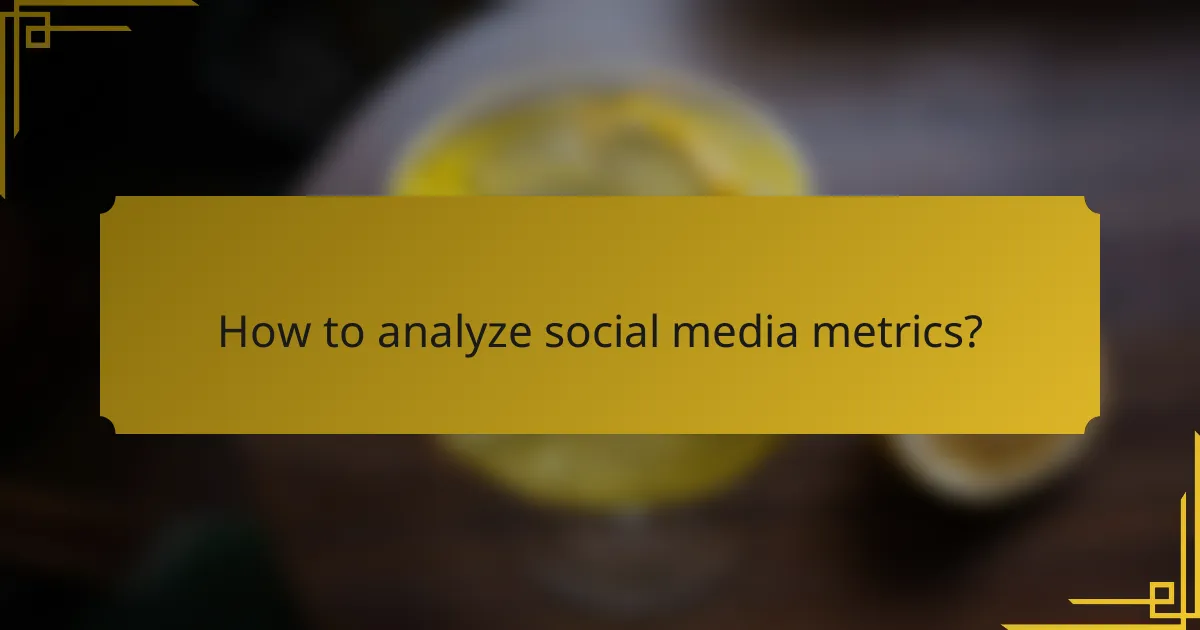
How to analyze social media metrics?
Analyzing social media metrics involves evaluating various performance indicators to understand audience engagement and content effectiveness. Key metrics include engagement rates, audience growth, and content performance, which provide insights into how well your social media strategy is working.
Identify engagement rates
Engagement rates measure how actively your audience interacts with your content. This includes likes, shares, comments, and overall interactions relative to your follower count. A typical engagement rate can range from 1% to 5%, depending on the platform and industry.
To calculate engagement rates, use the formula: (Total Engagements / Total Followers) x 100. Regularly monitoring these rates helps identify which types of content resonate most with your audience.
Track audience growth
Audience growth refers to the increase in followers or subscribers over time. This metric is crucial for assessing the effectiveness of your outreach and content strategies. A healthy growth rate is often considered to be around 2% to 5% per month.
To track audience growth, analyze your follower count at regular intervals and consider factors such as seasonal trends or specific campaigns that may have influenced spikes in growth. Tools like social media dashboards can automate this tracking for you.
Measure content performance
Content performance evaluates how well individual posts or campaigns achieve their intended goals, such as driving traffic or conversions. Key indicators include reach, impressions, and click-through rates (CTR). A good CTR typically ranges from 1% to 3% across various platforms.
To measure content performance effectively, set clear objectives for each post and use analytics tools to assess results against these goals. This approach allows for data-driven adjustments to future content strategies.
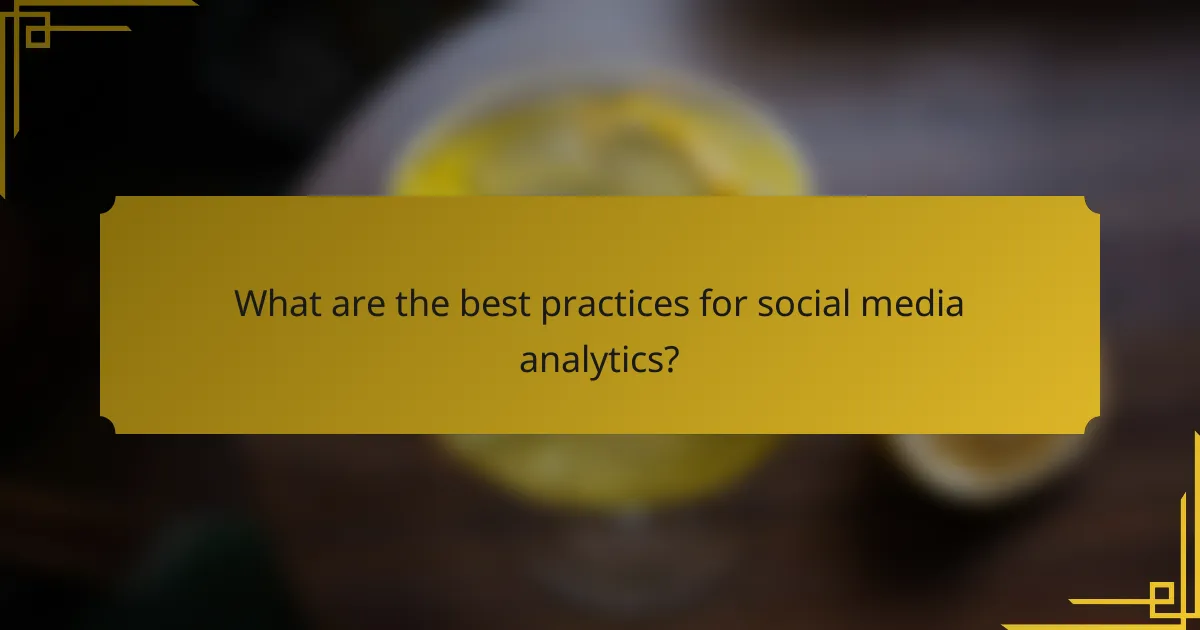
What are the best practices for social media analytics?
Best practices for social media analytics involve setting clear goals, selecting the right metrics, and regularly reviewing performance data. By focusing on specific objectives and using relevant tools, businesses can derive actionable insights to enhance their social media strategies.
Define clear goals
Establishing clear goals is essential for effective social media analytics. Goals should be specific, measurable, achievable, relevant, and time-bound (SMART). For example, a goal could be to increase engagement by 20% over the next quarter.
When defining goals, consider what you want to achieve, such as brand awareness, lead generation, or customer retention. This clarity will guide your analytics efforts and help you choose the right metrics to track.
Select relevant metrics
Choosing the right metrics is crucial for meaningful social media analytics. Focus on key performance indicators (KPIs) that align with your goals, such as engagement rates, reach, impressions, and conversion rates. For instance, if your goal is to increase brand awareness, track metrics like reach and impressions.
Additionally, consider qualitative metrics like sentiment analysis to understand audience perceptions. Regularly review these metrics to ensure they remain aligned with your objectives and adjust your strategy as needed.
Utilize analytics tools
Using analytics tools can streamline the process of gathering and interpreting social media data. Platforms like Google Analytics, Hootsuite, and Sprout Social offer comprehensive insights into your social media performance. These tools can help automate data collection and provide visual reports for easier analysis.
When selecting a tool, consider factors such as ease of use, integration capabilities, and the specific features that meet your needs. Many tools offer free trials, allowing you to test their functionality before committing.
Regularly review performance
Consistent review of social media performance is vital for ongoing improvement. Schedule regular check-ins, such as monthly or quarterly, to analyze your metrics and assess progress toward your goals. This practice allows you to identify trends, successes, and areas needing adjustment.
During these reviews, compare your performance against industry benchmarks to gauge how well you are doing relative to competitors. Use these insights to refine your strategy and make informed decisions moving forward.
Adjust strategies based on insights
Adjusting your social media strategies based on analytics insights is key to staying relevant and effective. If certain content types or posting times yield better engagement, consider prioritizing those in your future plans. Flexibility is essential in adapting to audience preferences and market changes.
Implement A/B testing for different strategies to determine what resonates best with your audience. This data-driven approach enables continuous improvement and helps optimize your social media presence over time.
